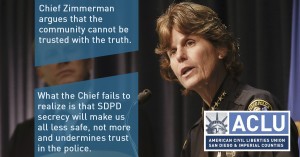San Diego Police Chief Shelley Zimmerman this week released a report on the Department’s first full year with body cameras on officers in three divisions (Southeastern, Central and Mid-City). The Chief is to be commended for tracking and releasing data – and for recognizing once again that body cameras are only part of the answer, as she told the San Diego Union Tribune. Sadly, the Department’s report and body camera policy underscore just how resistant to transparency the agency remains.
In its one year report on body cameras, the Department has released figures that tell the story they want to tell – and limit the public’s ability to get a full picture of what’s happening. In particular, they report that complaints regarding officer misconduct are down. They also report that, thanks to body camera footage, the number of complaints deemed “not sustained” (where there isn’t enough information to determine the validity of a complaint) has plummeted. What the Department won’t say is how many complaints were “sustained” (that is, where officers were found to have acted inappropriately or unlawfully).
The Department also emphasizes that use of force by officers and assaults on officers are both increasing. But the picture is actually mixed on use of force and the data too limited to evaluate the increase in assaults on officers. According to the Department, officer use of “greater” force has fallen by 8% from a year ago. This category includes tactics such as chokeholds, pepper spray, and Tasers. That’s good news. However, “lesser” force (such as an officer using his body weight to control an individual) has increased by 17%. Taken together, overall use of force incidents are up 10% over a year ago. Assaults on officers are up 36%. It’s unclear what this means for officers because we have no details on these assaults, a category which includes everything from spitting to kicking to worse.
It’s important to keep in mind that there are a number of other factors that could have affected these numbers, including unprecedented national attention and increased awareness of biased policing. It’s also quite possible that body cameras have influenced the way officers write their reports. Are officers reporting use of force instances and assaults on officers differently now than a year ago? We don’t know.
The Department seems to believe erroneously that this data release amounts to transparency of the impact of body cameras on policing in San Diego. It doesn’t. And in announcing the recent figures, Chief Zimmerman has doubled down on her refusal to release any video footage from body cameras. Though California law and SDPD’s own policies authorizes the Chief to release body camera footage, the Chief has made clear that she doesn’t want to do it. Neither the Chief nor SDPD policy has named any criteria by which she would make the decision to release body camera footage. So far, the Department has released only one body camera video – of an uneventful traffic stop meant to demonstrate for the public how body cameras work.
SDPD policy states that body cameras “may be an important tool for… maintaining public trust.” Theoretically, yes, but you’ve got to demonstrate trustworthiness to reap this reward from body cameras. So far, it’s not looking good for the Department.
Chief Zimmerman this week went so far as to urge a court to deny a request for release of a recent security camera video footage that captured a fatal officer-involved shooting. In her declaration to the court, the Chief argues that the community cannot be trusted with the truth. It would be too dangerous, she claims, to allow the public to view the video that captured a fatal shooting by an SDPD officer in a dark alley in the Midway District earlier this year.
What the Chief fails to realize is that SDPD secrecy will make us all less safe, not more and undermines trust in the police.
The ACLU has repeatedly urged the Department to release the video to demonstrate its commitment to transparency. Despite the Chief’s claims, the release of the video would not hamper investigation into the shooting nor would it threaten the privacy of any other party. The officer and Fridoon Rawshan Nehad, who died there, were alone in that alley. The officer inexplicably and in violation of SDPD policy failed to turn on his body camera.
In this case, the public’s interest in understanding what happened clearly outweighs the privacy interests of those involved. A man is dead; the involved officer has already been identified. The video will simply show what happened. The Department’s decision to urge the court to keep the video hidden sends a strong message that the SDPD is more interested in circling the wagons than committing to transparency with the community it serves.
David Trujillo is Advocacy Director for the ACLU of San Diego & Imperial Counties.

